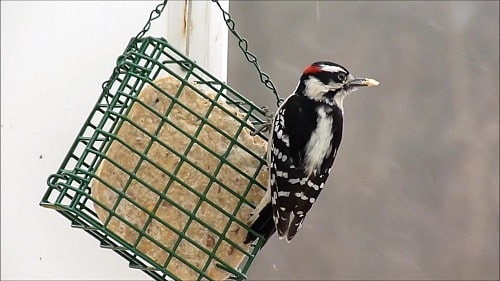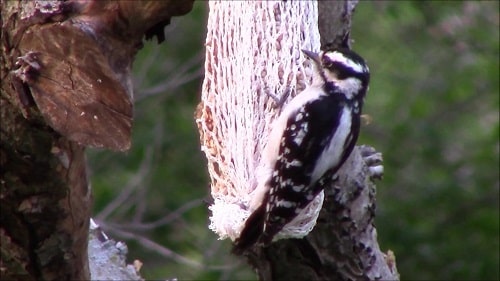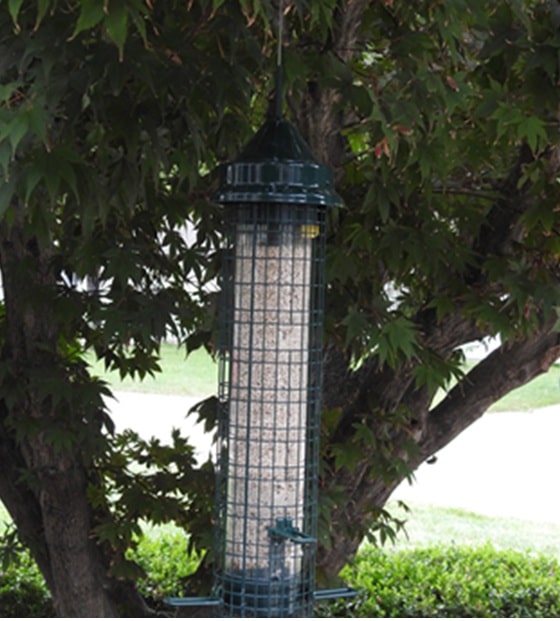Meet the Downy Woodpecker: Behavior, Nesting, and Diet
A field guide to the Downy Woodpecker's nesting and mating behaviors
Identification: Size, Field Marks
The Downy Woodpecker is the smallest of our North American woodpeckers, measuring about 6-7 inches long, which is approximately 2 inches shorter than the similar-looking Hairy Woodpecker.
It's a frequent visitor to backyard feeding stations and is generally more tolerant of humans than the Hairy Woodpecker.
This bird has a white back and underparts, with black wings that have white spots. Its face is black-and-white-streaked.

The males have red on the nape, while the females do not have any red.
You can find these birds in open woodlands, orchards, parks, and backyards.

Downy Woodpecker Call
Feeding Habits
Downy Woodpeckers feed on insects in the wild, particularly wood-boring larvae, caterpillars, and ants.
They also consume berries and seeds such as poison ivy, sumac, and acorns.
Additionally, it's common to see them drinking from hummingbird feeders and visiting sunflower seed feeders.
Winter Feeding
My favorite new way to keep the feeders busy in winter is by filling a thistle feeder with sunflower chips.

The small seeds are just the right size for delicate bills, and the birds waste no time working them out. It's simple, tidy, and keeps them coming back.
As an added perk, this setup brings in Black-capped Chickadees and American Goldfinches while keeping larger, pushier birds at bay.
The thistle feeder design does the gatekeeping for you, so the smaller songbirds can feed in peace.
And of course, there's always the old standbys like suet or peanut butter mixed with cornmeal, reliable favorites that never fail when it's cold outside.
If I'm using suet, I like to place multiple feeders around to not only encourage these and other woodpeckers, but also attract other birds like Nuthatches, Chickadees, and Flickers.
Do Downy Woodpeckers Mate for Life?
The short answer is that Downy Woodpeckers may re-pair from season to season but there is no data that suggests they mate for life.
Pair bonding is completed by March in the north and as early as February in the south.
Pairs will remain together throughout the summer months while raising young.
By mid-winter, if food sources are scarce, the female Downy will leave the male's territory.
Downy Woodpeckers may re-pair again in late winter, but there is no data available on how many re-pair as opposed to finding a new mate each season.
Breeding Season
Peak breeding season for the Downy is April - May. Downy Woodpeckers will drum on trees, posts, and other objects.
Drumming is a loud, continuous, rapid pecking on resonant surfaces such as dead tree stubs.
This is done to announce territory and to attract a mate during the breeding season.
During courtship, a flight display referred to as the "Butterfly Flight" is sometimes seen. This happens on a sunny, calm day before nesting.
While chasing each other through the trees, they hold their wings up high and flap slowly, like a butterfly.
Nesting Habits
As with most woodpeckers, the Downy's nesting habits begin with excavating a cavity in dead wood, about 5-50 feet above the ground. Both birds take turns with the excavation duties.
The entrance hole is approximately 1 to 1.5 inches wide, and the nest cavity is typically 7 to 10 inches deep when completed.
When Egg Laying Begins
Most Downy Woodpeckers lay eggs sometime between April and June depending on latitude.
More precise timing follows a clear south-to-north pattern:
- Southern states such as Florida and Texas: late April to early May
- Middle latitudes: May to June
- Northern latitudes: May to July
Clutches contain 4 to 6 white eggs, and both parents share incubation for about 12 days.
Incubation begins either when the last egg or the second to last egg is laid.
The male incubates and broods during the night and both share duties during the day.
The young will leave the nest about 18-21 days after hatching.
About 2-3 days before the young fledge the nest, the adults will reduce feeding to encourage the young to leave the nest.
Adults will continue feeding and teaching their young for as many as 3 weeks after the young leave the nest.
| Downy Woodpecker Nesting Stats | |
|---|---|
| Eggs | 4 - 6 average |
| Incubation | 12 days |
| Nestling Phase | 18- 21 days |
| Broods | 1 |
In southern states, they may raise 2 broods each season. They do not use man-made birdhouses for nesting but may use Bluebird houses for roosting.
I've personally watch them inspect birdhouses in late fall. I haven't been a witness to them roosting because it's too darn cold for me to stay outside and watch.
Do Downy Woodpeckers Reuse Nest?
While the pair will excavate a new nest each season, they will often use the same tree from one season to the next.
What Predators do They Have?
Predators include American Kestrel, Cooper's Hawk, and Sharp-shinned Hawk. These species can catch the Downy in the air or on feeding trips.
Predators at the nest site include Gray and Red squirrels along with flying squirrels. Rat snakes also attack nest and eat both eggs and nestlings. At bird feeders, cats can be a problem.
See Also: Look-A-Like, Hairy Woodpecker
What is Their Average Lifespan?
While there have been banded Downy Woodpeckers (male and female) that have live 11+ years there is no data on the average lifespan of this woodpecker.
Most fledglings do not survive their first year. If they do survive that first year, the Downy has an estimated lifespan of 2-5 years in the wild.
That estimation is based more on the typical lifespan of the average backyard bird, and not studies.
Summary
By providing the right food and habitat, you can attract these woodpeckers and enjoy watching their courtship displays, nesting habits, and parenting behaviors.
While there are still some mysteries surrounding their lifespan and mating habits, the joy of observing these beautiful birds in your own backyard is a reward in itself.
So, next time you hear that distinctive drumming sound, take a moment to appreciate the presence of the charming Downy Woodpecker.








